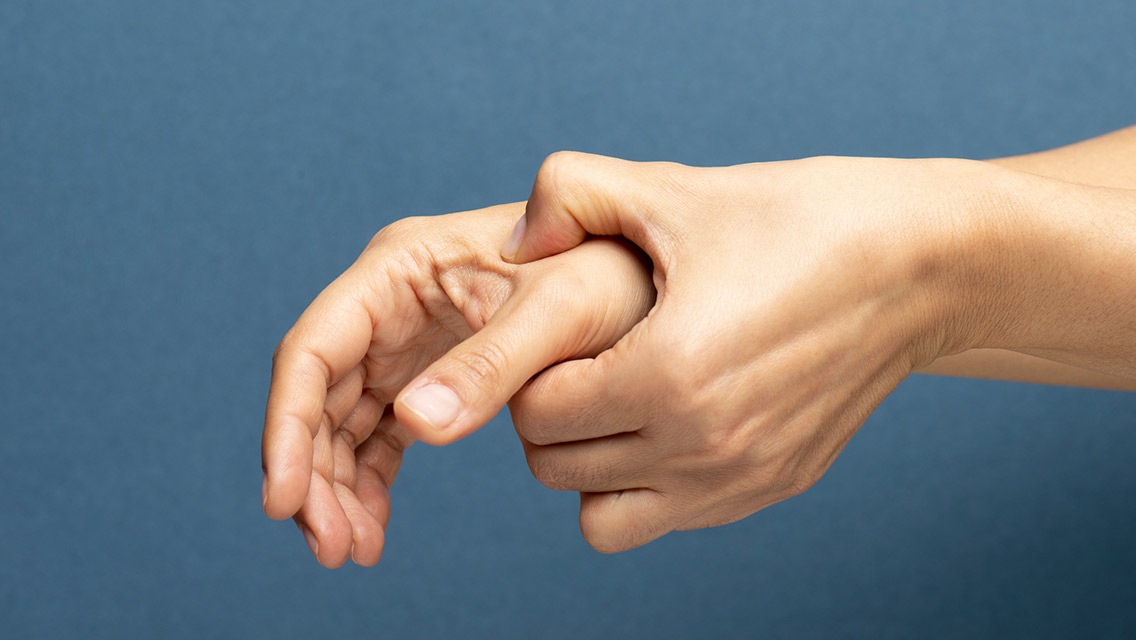Sue Knutson was hiking along a mountain path that angled sharply and disappeared into a mountain stream. She leapt across the water, rock by rock. On the last jump, her foot slipped between two boulders. She felt sharp pain in her ankle, and then she was laid out flat on her back in the wilderness, miles from civilization and medical care.
Holding her leg in the air, she used the only resource available – her hands – to reduce the shooting pain and minimize swelling that had already begun to inflate her ankle. Knutson, a nurse and practitioner of an alternative therapy called healing touch, held her hands a few inches from her ankle and focused on balancing her body’s energy field disrupted by the injury. The swelling subsided, the pain began to ebb, and within 30 minutes she was able to limp out to the road unassisted. The next day, doctors told her that she had a severe medial lateral sprain and should expect to be in a cast from four to six months. A mere six weeks later, Knutson was not surprised that her ankle had healed enough for doctors to remove the air splint.
Faster Healing
Magic? Mystical intervention? Hardly.
On the hiking trail, Knutson used her mental focus and her hands to reestablish the flow of energy that had been disrupted at the site of her injury, rallying her body’s healing forces to the sprain. This technique, called healing touch, is a noninvasive therapy that relieves pain, reduces physical and emotional stress and accelerates the body’s own healing capabilities. Knutson’s experience out on the hiking trail may seem miraculous, but more and more doctors are beginning to understand how the body’s own energy can aid in healing. Even hospitals are using healing touch to help patients recover from surgery.
“There are many scientists who believe energy medicine will be the source of the next great advances in healthcare.”
A fundamental principle of healing touch, and other therapies such as acupuncture, Reiki and reflexology, is that a person’s entire body participates in healing a trauma or injury. The human energy system has been known since the time of Hippocrates, but only in the last decade has it begun to be defined and understood in scientific terms.
Researchers can now observe and measure the field of biomagnetic energy that surrounds and penetrates the human body. Using laboratory equipment, they’re beginning to understand what happens to the human energy system at a cellular level when injury occurs and healing begins.
“The debate about whether there is such a thing as healing energy or life force is being replaced with the study of the interactions between biological energy fields, structures and functions,” says James Oschman, PhD, a member of the Scientific Advisory Board for the National Foundation for Alternative Medicine in Washington, D.C., who has been researching how energy medicine works. “There are many scientists who believe energy medicine will be the source of the next great advances in healthcare.”
Low Tech, High Impact
Oschman and other researchers are studying how healing touch helps patients in ways high-tech medicine can’t. Relaxation, relief from pain and lowered anxiety translates into better clinical outcomes. At Abbott Northwestern Hospital in Minneapolis, surgery patients who receive healing-touch therapy are calmer before surgery, and require less medication for pain after it, according to Lori Knutson, director of integrative medicine (no relation to Sue Knutson). At Scripps Center in San Diego, healing touch is standard protocol for the patients of cardiologist Mimi Guarneri, MD. “Mind, emotions and spirit are all involved in healing,” says Guarneri. “After open-heart surgery, healing touch can help patients turn the corner.”
“Mind, emotions and spirit are all involved in healing,” says Guarneri. “After open-heart surgery, healing touch can help patients turn the corner.”
Today there are more than 1,700 certified healing-touch practitioners (most are RNs or other healthcare professionals) who have completed a rigorous five-level program and demonstrated mastery of healing-touch techniques with patients prior to practicing healing touch in everyday healthcare settings.
This number is expected to climb by 10 percent next year and will double in five years, according to Anne Day, past president of Healing Touch International. More than 30 hospitals in the United States have healing-touch programs firmly established, says Lisa Anselme, a liaison and adviser to hospitals that want to introduce healing-touch methodologies.
Proof in the Practice
At St. Joseph’s Hospital in St. Paul, HealthEast is planning a Holistic Heart Care Center, where healing touch will be part of a one-stop recovery area that integrates body, mind and spirit principles. Theresa Fricke, RN, is one of two certified healing-touch practitioners hired at St. Joseph’s after a study clearly demonstrated the positive effects of healing touch on patients undergoing coronary artery bypass surgery.
Working with cardiac patients every day, Fricke sees that after a healing-touch session her patients’ facial muscles and shoulders are more relaxed, the color of their complexion improves and there is an aliveness and peace in their eyes that wasn’t there before. “Healing touch helps patients face their procedures with more confidence. They get a feeling like, ‘I can do this now,'” she says.
“One healing-touch session can ease pain in patients for up to several days without the side effect of drugs.”
Healing touch is also being used to alleviate the side effects of chemotherapy. A study of 164 cancer patients published in the Integrative Cancer Therapies journal in 2003 found that healing touch reduced pain and fatigue, increased energy and improved mood in chemo patients. “One healing-touch session can ease pain in patients for up to several days without the side effect of drugs,” says Michael Ryan, MD, an oncologist and cancer specialist in Willmar, Minn.
More dramatic are the results reported by patients like Kevin Wiggins, who recovered from a broken jaw in less than half the time physicians expected. Wiggins, a personal trainer in Oakland, Calif., fractured his jaw when he fell in the shower. During and following surgery to repair Wiggins’s jawbone, certified healing-touch practitioner Tom Sherman was at his side administering healing touch. Although doctors told him his jaw would be wired shut from four to six weeks, it healed quickly enough to remove the wires in 17 days. “My doctors were amazed at how wide I could open my mouth,” he says. “I could even brush my back molars.”
Even as researchers continue to study healing touch, practitioners like Knutson demonstrate its powers patient by patient. Not long after Knutson recovered from her hiking sprain, she was in the hospital cafeteria line when the person in front of her scalded her hand with coffee. Even before a bystander returned with an ice pack, Knutson was using healing touch to unblock, realign and balance the flow of energy on the woman’s hand. Within 15 minutes, the redness was fading and the emerging second-degree-burn blister had begun to recede.
“A week later she stopped me in the hall and showed me her hand. It looked as if nothing had happened to it,” Knutson says. The proof of the power of healing touch, says Knutson, is in its practice.
What to Expect During a Healing Touch Session
Healing touch was developed by Janet Mentgen, RN, in 1989 as a healing therapy that works with the energy system surrounding and penetrating the body. This energy system is dynamic and organized, with energy running in tracts (meridians) and concentrated in seven energy centers (chakras) located at specific points from the base of the spine to a point over the crown of the head. Healing touch draws on an Eastern philosophy that unites mind, body and spirit.
The goal of the therapy is to balance and align the energy system. Working with their hands, palms down several inches from the body, practitioners are sensitized through training to feel the presence and movement of energy. When the practitioner locates areas where the flow of energy is not moving (blocked) or is not flowing smoothly (out of balance), he or she may use any of a number of techniques (hand-movement patterns) to release energy, and to balance and align the energy system.
Sessions can take 20 minutes to an hour, and clients remain fully clothed, reclining on a massage table or sitting in a chair. Eyes can be open or closed. Occasionally the practitioner may gently hold an area of the body.
Healing touch relaxes body, mind and spirit. Some people experience a tingling sensation or a sense of warmth or coolness over areas of the body, or they may even feel the energy move as the practitioner works. The effectiveness of the treatment, however, is independent of the patient’s ability to discern energy moving.
This article has been updated and originally appeared as “The Touch That Heals” in the December 2004 issue of Experience Life.




This Post Has 0 Comments